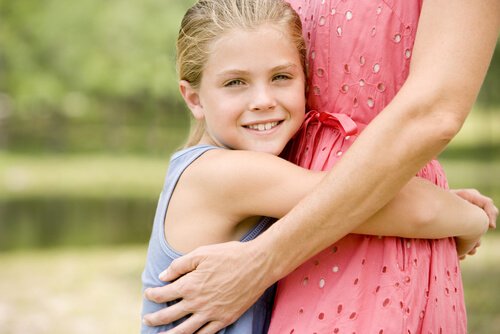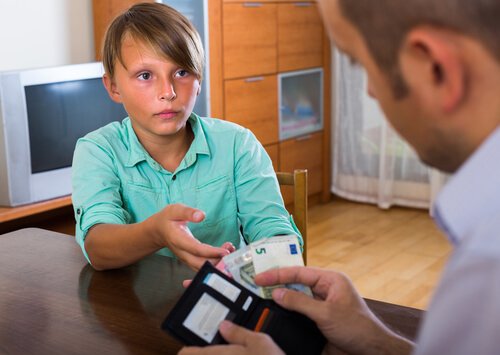How to Respond to Children's Good Behavior

The way parents respond to their children’s good behavior is fundamental for their education and development. Below we’ll offer some recommendations and advice to reward children’s positive actions.
How to respond to children’s good behavior
The measures listed below, presented by the US Department of Health and Human Services, are fundamental in correctly responding to children’s good behavior while reminding them that acting appropriately is their responsibility. They also work as a strategy for children to learn to acquire rewards through good actions.
These are some of the best recommendations:
Types of compliments
In most cases, we should praise our children’s good behavior. However, what kind of praise is correct?
Some types of praise are very specific to each child, and others tend to have less relevance. The first ones should be used when children perform an activity in which they invested a great amount of effort. This may include good academic performance or getting good grades in difficult subjects.
In the case of actions with a little less relevance, but which still carry importance, an example may be a child who helps clean up the table. Actions like this should also receive praise.
The praise doesn’t necessarily have to be verbal. It can also occur through gestures, such as hugs or a high five. The fundamental thing, in any case, is to highlight children’s good behavior and demonstrate the love that the parents feel.

Positive attention
Parents’ attitudes will always be fundamental. They can directly influence their children’s personalities. When children see negative attitudes and responses from their parents, they see them as an example and begin to behave inappropriately.
For this reason, it’s important to avoid responding to tantrums or helpless attitudes.
Positive attention, on the other hand, is a response to good attitudes. For example, if your children get good grades in school, highlight this fact during dinner time.
This way, your children will understand that they’re doing the right thing. Being congratulated causes them to repeat this action.
It’s important to note that too much positive attention could also be harmful. Praise shouldn’t come in great quantities. If it does, children could begin to behave well only for these rewards and not because they feel it’s the right thing to do.
“Punishing a child physically can inhibit bad behavior in the short term, but not in the long run.”
Keys to improving children’s behavior
Positive reinforcement techniques can be very beneficial to promote children’s good behavior. These methods not only work to avoid behavior problems, but can also be used to establish new desired behaviors.
- Good behaviors must be rewarded and bad attitudes ignored. As a reward, parents can use a smile, a hug or a compliment. Other types of rewards include going for a walk or watching a movie.
- Parents should always show gratitude and pride for their children’s accomplishments. This not only encourages this type of behavior, but also cements the foundations of a stronger self-esteem.
- By highlighting negative attitudes, you’ll only receive more negative attitudes. The hardest part of this technique is being patient in the face of a tantrum, but it’s essential in order to reinforce children’s good behavior.

- Be constant, persevering and consistent with the techniques you use. It can be difficult to keep these three adjectives present, because not all children are the same. They can have very different attitudes.
- Developing routines and rituals can help make moments of conflict more bearable. For example, at bedtime, ask your children each night, “Do you prefer blue or green pajamas?” Children usually respond better when involved in the process.
Teaching values and good behavior in the home is fundamental to ensure that your children have good attitudes both socially and personally.
It’s essential for parents to remember that their reactions are a mirror for their children. They must act correctly in any situation.
The way parents respond to their children’s good behavior is fundamental for their education and development. Below we’ll offer some recommendations and advice to reward children’s positive actions.
How to respond to children’s good behavior
The measures listed below, presented by the US Department of Health and Human Services, are fundamental in correctly responding to children’s good behavior while reminding them that acting appropriately is their responsibility. They also work as a strategy for children to learn to acquire rewards through good actions.
These are some of the best recommendations:
Types of compliments
In most cases, we should praise our children’s good behavior. However, what kind of praise is correct?
Some types of praise are very specific to each child, and others tend to have less relevance. The first ones should be used when children perform an activity in which they invested a great amount of effort. This may include good academic performance or getting good grades in difficult subjects.
In the case of actions with a little less relevance, but which still carry importance, an example may be a child who helps clean up the table. Actions like this should also receive praise.
The praise doesn’t necessarily have to be verbal. It can also occur through gestures, such as hugs or a high five. The fundamental thing, in any case, is to highlight children’s good behavior and demonstrate the love that the parents feel.

Positive attention
Parents’ attitudes will always be fundamental. They can directly influence their children’s personalities. When children see negative attitudes and responses from their parents, they see them as an example and begin to behave inappropriately.
For this reason, it’s important to avoid responding to tantrums or helpless attitudes.
Positive attention, on the other hand, is a response to good attitudes. For example, if your children get good grades in school, highlight this fact during dinner time.
This way, your children will understand that they’re doing the right thing. Being congratulated causes them to repeat this action.
It’s important to note that too much positive attention could also be harmful. Praise shouldn’t come in great quantities. If it does, children could begin to behave well only for these rewards and not because they feel it’s the right thing to do.
“Punishing a child physically can inhibit bad behavior in the short term, but not in the long run.”
Keys to improving children’s behavior
Positive reinforcement techniques can be very beneficial to promote children’s good behavior. These methods not only work to avoid behavior problems, but can also be used to establish new desired behaviors.
- Good behaviors must be rewarded and bad attitudes ignored. As a reward, parents can use a smile, a hug or a compliment. Other types of rewards include going for a walk or watching a movie.
- Parents should always show gratitude and pride for their children’s accomplishments. This not only encourages this type of behavior, but also cements the foundations of a stronger self-esteem.
- By highlighting negative attitudes, you’ll only receive more negative attitudes. The hardest part of this technique is being patient in the face of a tantrum, but it’s essential in order to reinforce children’s good behavior.

- Be constant, persevering and consistent with the techniques you use. It can be difficult to keep these three adjectives present, because not all children are the same. They can have very different attitudes.
- Developing routines and rituals can help make moments of conflict more bearable. For example, at bedtime, ask your children each night, “Do you prefer blue or green pajamas?” Children usually respond better when involved in the process.
Teaching values and good behavior in the home is fundamental to ensure that your children have good attitudes both socially and personally.
It’s essential for parents to remember that their reactions are a mirror for their children. They must act correctly in any situation.
All cited sources were thoroughly reviewed by our team to ensure their quality, reliability, currency, and validity. The bibliography of this article was considered reliable and of academic or scientific accuracy.
- Martin, M. Á. L. (2014). Cómo intervenir en los problemas de conducta infantiles. Padres y Maestros/Journal of Parents and Teachers, (356), 37-44. https://revistas.comillas.edu/index.php/padresymaestros/article/view/3071
- Noroño Morales, N. V., Cruz Segundo, R., Cadalso Sorroche, R., & Fernández Benítez, O. (2002). Influencia del medio familiar en niños con conductas agresivas. Revista cubana de Pediatria, 74(2), 138-144. http://scielo.sld.cu/scielo.php?script=sci_arttext&pid=S0034-75312002000200007
This text is provided for informational purposes only and does not replace consultation with a professional. If in doubt, consult your specialist.








